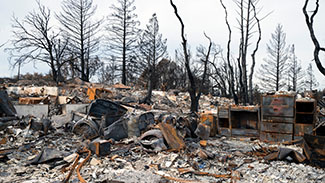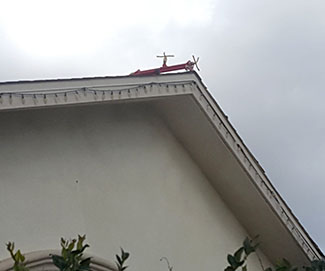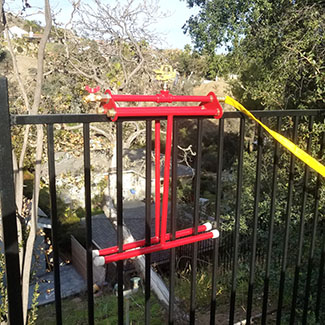Can You Build an Arizona House to Survive a Wildfire?
 21 May 2019
21 May 2019 

Build for a Lifetime
Everyone was horrified at last year's fires in California, but then we read a newspaper account about a home in Malibu that survived one of the worst wildfires ever in that state.

The house had concrete and steel walls, rooftop ember guards and heat-resistant windows. The roof was covered with fire-rated underlayment topped with concrete-plus-clay tile; the walls were covered with high-performance stucco. Fire and safety measures helped raise the cost of the house into the multi-million-dollar category, but the walls and roof still stood. Meanwhile, the rest of the neighborhood burned to ashes.
Arizona doesn't seem to have as many risks as California or Florida do. There are no major earthquakes or hurricanes. No "tornado alley," although major tornadoes have hit Coconino County in the recent past. And we can't forget the monsoons and flash floods we have.
There certainly are wildfires here in Arizona. In May 2018, for example, there was the Tinder Fire, northeast of Payson that burned 16,000 acres and destroyed 41 structures, including more than 29 homes. That fire was started by an abandoned campfire. The California fires last year were the result of defective electrical power lines.

Building materials
So, in light of the fact that the summer season of wildfires might not be far away, here is a list of materials and techniques that can be used during building to provide more fire protection for an Arizona home:
- Concrete block or concrete slabs, reinforced with steel, are among the best construction materials to use in creating walls for a fire-resistant home.
- Stucco, or portland cement plaster, is a versatile facing material that can be applied to a home's outside surfaces. It's a tough exterior that can also be fire-resistant and resistant to rot and fungus, according to manufacturers.
- Roofing can have fire-retardant qualities. One possibility is using a fire-rated underlayment and then covering it with clay or concrete tiles. A metal roof would be even better if it can cover all the wood framing underneath.
 You can even put mini-sprinklers called ember guards in crucial spots on the roof of your house. You can put metal flashing over the wooden fascia boards around your roof.
You can even put mini-sprinklers called ember guards in crucial spots on the roof of your house. You can put metal flashing over the wooden fascia boards around your roof.
Of course nothing can work perfectly we found out when we asked Alexander Pajic, a project manager for ROTH Remodeling, regarding how these special building materials can stand up to fire and what limits there might be for protection.
Even a concrete block, concrete slab or brick house can be damaged during a severe fire, he noted. The amount of damage depends on the duration, temperature and location of the fire.
He told us: "It might still be standing, but there can be severe problems with smoke, no matter how it's built. Noxious fumes and carbonation can affect the bearing capability of concrete. The mortar between concrete blocks will be damaged. Even if a house is still standing, you might have to scrape the paint off the walls and tear down the drywall because of the smoky odor and exposure to noxious fumes. A house can't totally 'survive' a fire."
In addition if the concrete is reinforced with steel, the steel can still lose its bearing ability during a fire. Steel studs can become unstable, Pajic said.
Defensible space and fire resistant plants

It can be very important, of course, to build a defensible space around your house to discourage fire from getting too close to you if you live near lots of open space. Defensible space is an area around a structure where fuels and vegetation are reduced to slow the spread of wildfire toward the structure. It's a space that can allow firefighters to do their job, according to the University of Arizona Cooperative Extension Service.
The extension service says landscaping is possible in this defensible area, but plants should be more widely spaced and lower growing. Plant in small irregular clusters or islands. Use decorative rock and stepping stone pathways. Plant low-growing non-resinous shrubs and ground cover plants. Remove annuals and perennials after they go to seed or when stems become dry.
More recommendations from the Arizona Interagency Wildfire Prevention Group and other groups:
- Plant fire-resistant shrubs and plants. Among them are some Arizona favorites: agaves, aloes, lantanas and yuccas.
- Space plants to slow the spread of fire from plant to plant.
- Keep roofs free of dried leaves and plant debris.
- Keep vegetation more than five feet away from your walls and prune regularly. Trim back tree limbs that might touch your house or roof.
So what really saved the house in Malibu? Without visiting the house to see what happened, we noticed photos that showed the home was at the very top of a hill, a location that might have helped. In addition the homeowner had huge water tanks next to his house for use by the fire department and he had installed a 1,000-foot-long hose for watering his walls and roof.
###
Photo Credits:
RELATED CONTENT:
- Rosie App: Learn More About HomeZada
- Blog: 3 Ways To Add More Drama To Your Arizona Backyard
- Blog: What to Do When the Floor Starts ‘Heaving’?
- DIY Q&A: What Are Some Tips for Buying and Installing Smoke Alarms?
- DIY Q&A: How & When To Spring Deep Clean Your Home
- DIY Q&A: Four DIY Projects That Help Pay for Themselves
- Podcast: 5 Ways To Make Your Desert Yard More “Sustainable”
Print this page
recent post
- Duck, Duck, Duct! How Often Should Ductwork Be Cleaned?
- Vinyl vs. Fiberglass Windows: Which Is The Better Choice Of Replacement Window?
- We May Be The Grand Canyon State, But The Rocky Mountains Are Important For Arizona
- Welcome to Arizona! Things A Newbie to Arizona Should Know
- The Pros & Cons of Buying A Flipped House
- Getting In On The Ground Floor
- Why It’s More Critical Than Ever To Get Your AC Serviced Before Summer
- The Reality of Remodeling
- What To Look For When Comparing Your Roofing Quotes
- What To Expect When Buying New Windows & Doors
